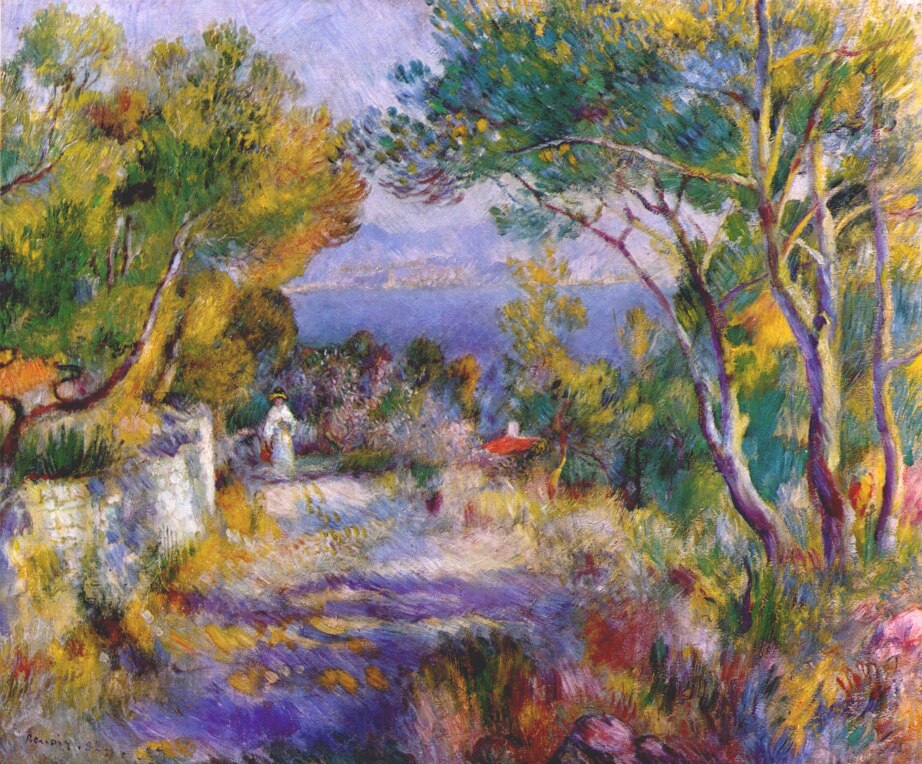art-Renoir.com
Auguste Renoir 1841-1919
Auguste Renoir - The Estaque 1882
 The Estaque |
From Christie's auction house:
By 1882, Renoir had reached the zenith of his Impressionist style. He had been taken under the wing of the dealer Paul Durand-Ruel and had won high profile patrons at home in Paris, most notably Marguerite Charpentier who hosted a famous Salon at which Renoir, as well as Manet and Sisley, was an habitué. The early 1880s were also marked by a flurry of international travel for Renoir as he visited Algeria and then Italy.
It was on his return from Italy, in January 1882, that Renoir stopped to stay with Paul Cézanne at l'Estaque, close to Marseilles in the South of France. Despite his recent commercial success, Renoir, at the age of forty, was still plagued by the same sort of self-doubt that tortured Cézanne throughout his life. However, Renoir found inspiration in the Mediterranean landscape. Writing to Marguerite Charpentier, to explain an extension to his stay with Cézanne, Renoir enthused: 'I am in the process of learning a lot, and the longer I take, the better it will be...I have perpetual sunshine and I can scrape off and begin again as much as I like. This is the only way to learn' (quoted in J. Rewald, The History of Impressionism, New York, 1973, p. 463).
Writing to another of his patrons, Paul-Antoine Berard, Renoir rhapsodised further on the charms of the Provencal landscape: 'How beautiful it is! It's certainly the most beautiful place in the world, and not yet inhabited... There are only some fishermen and the mountains... so there are no walls, no properties or few... here I have the true countryside at my doorstep' (quoted in Renoir, exh. cat., London, 1985, p. 233).
Painted during his stay in 1882, L'Estaque shows how much this freedom from constraints, of which he had had an early taste in Algeria, now had an impact on his work. Although Renoir had painted landscapes for many years, until 1880 his focus had been on figure pictures. The Mediterranean countryside left him so enthused that he began to devote himself fully to the landscape itself as a subject matter. In the same letter to Marguerite Charpentier quoted above, he spoke of his desire to 'kindle the sun'.
Renoir no longer merely sought to capture the light of a single moment, feeling this denuded the reality of some of its texture, realising that 'by dint of studying out of doors I have ended up by only seeing the broad harmonies without any longer preoccupying myself with the small details which dim the sunlight rather than illuminating it' (quoted in Renoir, op. cit., p.232). The delicate sense of shadow and contrast in L'Estaque shows Renoir putting his recent researches to good effect, looking with a new objectivity at sunlight and its effects.
While Italy and Algeria had made their relative impacts on the development of Renoir's work, perhaps the most important spur to development was his host, Cézanne. The steady construction of the volumes and depths in L'Estaque through hatched brushstrokes are clearly reminiscent of Cézanne's own discoveries. Although Renoir had already developed a visual idiom involving the dabbed application of paint, often helping to create his hallmark softness especially in flesh, here the strokes have been put in parts to more deliberate use, acting almost as bricks as Renoir created a more solid sense of form. The diagonal brushstrokes are emphasised to convey a sense of volume that in turn benefits the entire lushness of the verdure, giving the scenery a striking palpability reinforced by the artist's new, stricter understanding of light.
Cézanne's ability to capture a sense of volume, so evident in paintings such as The Sea at l'Estaque, where the houses have an almost three dimensional quality, is here converted by Renoir in a more discreet manner. Although his love of sensuality in his art disallowed him from following Cézanne's path too closely, he nonetheless managed in L'Estaque to adapt this sense of volume to create an enhanced sense of sensuality to the greenery and the coastal scenery. His love of flesh has been translated into a love of landscape.
The combination of these various influences make L'Estaque one of Renoir's formative landscapes, showing him hone and display the skills and techniques which would feature again and again in his works. Paintings such as Landscape near Menton, painted the next year as well as many later landscapes retain the traces of the explorations of form and light that Renoir carried out at l'Estaque.
The provenance of the present work bears testimony to its pioneering nature. It was acquired directly from the artist by Durand-Ruel, from whence it passed to Juliana Cheney Edwards of Boston, wife of the textile magnate, Jacob Edwards, whose later role as a banker earned him the nickname 'The Morgan of New England' in refernce to New York's J. Pierpoint Morgan. Juliana's collection, assembled in the early years of the twentieth-century, included a sparkling array of Impressionist masterpieces, including five other Renoirs, amongst them Rochers à l'Estaque (Boston, Museum of Fine Arts), two Sisleys, two Pissarros, a Degas and an incredible group of ten Monets. Among the Monets was Antibes, vue du plateau Notre-Dame (W.1172) and Cathédrale de Rouen, Effet de soleil (W.1356), both still preserved in the collection of the Museum of Fine Arts in Boston. On Juliana's death, L'Estaque, along with the other pictures, passed to her children and in 1939 was included in a generous bequest to the Museum.